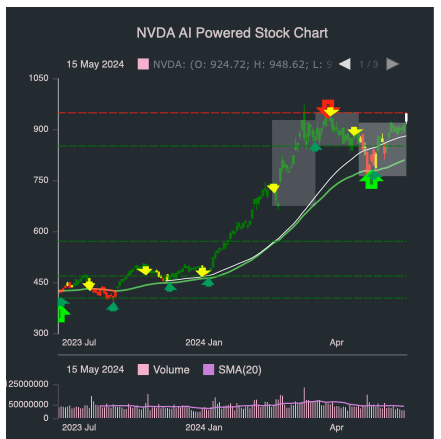20 Good Tips On Choosing AI Stock Investing Analysis Websites
20 Good Tips On Choosing AI Stock Investing Analysis Websites
Blog Article
Top 10 Tips For Assessing The Market Coverage For Ai Stock Predicting/Analyzing Trading Platforms
Market coverage is an essential element to take into consideration when evaluating AI platform for predicting or analyzing stocks, as it determines the depth and breadth of markets and assets which you have access to. With a platform that provides comprehensive coverage, you can diversify your portfolio and take advantage of global opportunities. It is also possible to adapt to different trading methods. Here are the top ten ways to assess the market cover of these platforms.
1. Evaluate Supported Asset Classes
Stocks: Make sure your platform is compatible with major stock exchanges like NYSE, NASDAQ LSE and HKEX, and that it includes small, mid and large-cap stocks.
ETFs Check whether the platform allows you to select from a wide range of ETFs. This gives you an array of exposure.
Futures and options: Determine whether the platform supports derivatives, such as futures, options, and other instruments that leverage.
Forex and commodities: See whether your platform has commodities and forex, precious metals, and energy commodities.
Cryptocurrencies: Make sure the platform supports major cryptocurrencies (e.g., Bitcoin, Ethereum) and altcoins.
2. Check for Geographic Coverage
Global markets. Make sure your platform is able to cover the largest market in the world that includes North America Europe Asia-Pacific and emerging countries.
Make sure you focus on regional markets. Find out if the platform focuses on particular markets or regions which are in line to your business goals.
Local exchanges: Determine whether your platform is compatible with regional and local exchanges relevant to your business or your strategy.
3. Assessment Real-time against. Delayed Data
Real-time data: Ensure that the platform provides real-time market data to make quick decisions, particularly for trading that is active.
Delayed data - Check whether delayed data is available for free or is available at a lower price. This could be enough to investors who want to invest for the long term.
Data latency. Verify whether the platform minimizes the delay for feeds of information that are real-time particularly for high-frequency trading.
4. Review historical data availability
The depth of historical data Check that the platform provides extensive data (e.g. over 10 years old) for backtesting.
The granularity of the data: Determine if the historical data include intraday, daily weekly, monthly and intraday granularity.
Corporate actions: Confirm that the historical data taken into account splits in stock (if applicable), dividends, and any other corporate actions.
5. Review market depths and make an order for books
Level 2 data: Make sure that your platform is equipped with Level 2 data for price discovery and better execution.
Verify that your platform is showing live price spreads.
Volume data: Find out if your platform provides detailed volume data to analyze market activity and liquidity.
6. Assess the Coverage of Indices Sectors
Major indices - Make sure the platform is compatible with major indices such as S&P 500 and FTSE 100 for benchmarking.
Sector-specific data: To perform a focused analysis, determine if the platform has data for certain industries (e.g. technology, health care, technology).
Customized indices. Check that the platform is able to track or create customized indices that meet your needs.
7. Examine the integration of News and Sentiment
News feeds - Ensure the platform is integrating real-time news feeds for market-moving news from trusted (e.g. Bloomberg or Reuters) sources.
Sentiment analysis: See whether the platform offers tools for analyzing sentiment based on news media, social media or other data sources.
Events-driven Strategies: Determine if the platform supports strategies that are driven by events (e.g. economic reports, earnings announcements).
8. Test for Multi-Market Trading
Cross-market trading : Ensure that the platform allows trading on multiple markets, asset classes and exchanges via a single interface.
Currency conversion: Make sure that the platform supports multi-currency accounts and automatic currency conversion to trade internationally.
Support for various time zones: Make sure the platform supports trading on global markets in different time zones.
9. Evaluation of Alternative Data Sources
Alternative data - Check to determine if there are other data sources that are included in the platform (e.g. web traffic, satellite imagery or transactions with credit cards). This can give you unique insight.
ESG data - Verify that the platform is able to provide environmental, governance, and social data (ESG). This is important for the socially conscious investment.
Macroeconomics data: for a more an analysis of fundamentals, make sure the platform is stocked with macroeconomic indicators such as GDP (gross domestic product) as well as inflation rates and interest rate.
Examine the Feedback of Users and Market Reputation
User feedback is a fantastic method of evaluating the market the platform's coverage.
The reputation of the company: Find out whether the platform has been acknowledged by experts in the industry for its market coverage.
Case studies: Look for case studies, testimonials, and other information that highlights the effectiveness of the platform on particular markets or asset categories.
Bonus Tips
Trial period for free: Check the market coverage of the platform as well as its data quality by using the demo or trial for free.
API access - Determine if the API is able to access data on the market programmatically.
Support for customers: Ensure whether the platform has assistance for questions related to data or markets.
The following tips can aid you in assessing the market cover of AI stock-predicting/analyzing trading platforms. You can choose one that gives you access to markets and data to ensure successful trading. Market coverage is important to diversify portfolios, discover new opportunities and to adapt to changing market conditions. Read the recommended ai stock picker tips for more examples including ai for stock predictions, stock ai, ai stock trading bot free, trading with ai, ai stock market, ai investment app, ai stock trading app, ai stock trading app, best ai stock, best ai trading app and more.
Top 10 Tips On Assessing The Speed And Latency Of Ai Stock Predicting/Analyzing Trading Platforms
For high-frequency, algorithmic, and active traders in particular, speed and latencies are key factors when looking at AI platforms for stock forecasting and analyzing. Even millisecond delays can have an impact on the success of the trade. Below are the top ten tips for assessing speed and latency on these platforms:
1. Real-time data feeds that are to be analyzed
Data delivery speed: Ensure the platform delivers real-time data with a minimum delay (e.g. less than a millisecond delay).
Nearness of the data source: To cut down the time needed to transmit data, check whether your server's servers are able to be found near exchanges that are major.
Data compression - Make sure that the platform is using efficient techniques for data compression to increase data delivery speed.
2. Test the speed of execution for trades
Order processing: The platform's ability to complete and process trades fast once an order has been submitted.
Direct market access (DMA). Check to see if the platform you are using has DMA. DMA allows orders that are sent directly to exchanges to be processed with no intermediaries.
Make sure you have a detailed report on the execution, which includes timestamps and confirmations of your order.
3. Examine the Platform's Responsiveness
User interface (UI also known as speed of user interface): This is the speed at which the platform's user interface reacts to the inputs you type in (e.g. pressing buttons, loading graphs).
Updates to charts - Check that your charts are up-to-date in real time and without any delay.
Performance of mobile apps. When you use mobile apps make sure it's functioning as swiftly and smoothly as the desktop application.
4. Look for networks with low-latency infrastructure.
Server Locations: Check whether the server used by the platform is with low latency located near major financial exchanges or hubs.
Co-location services: Find out whether your platform has this feature. This lets you host trading algorithms on servers near to the exchange.
High-speed Networks: Confirm the application's use of a fiber-optic high-speed network, or other technology with low latency.
5. Backtesting and Evaluation of Simulation Speed
Historical processing of data: Find out the speed at which your platform analyzes and processes data from the past.
Simulation latency: Make sure that the platform simulates trades in real-time without noticeable delays.
Parallel processing: Find out whether the platform uses distributed computing or parallel processing to speed complex calculations.
6. Estimate API Latency
API response time: Measuring how quickly the platform’s API responds (e.g. fetching market data or placing orders).
Rate limits. Check to see what limits are appropriate on the API. This will assist in avoiding delays in high-frequency transactions.
WebSocket: Check whether the platform is compatible with WebSocket protocols that allow streaming of data in real-time with low latency.
7. Test Platform Stability During Loading
High-volume trading: Create high-volume trading scenarios in order to determine if the platform remains reliable and stable.
Test your platform during periods of extreme market volatility.
Stress testing Check whether the platform allows users to test their strategy under extreme conditions.
8. Evaluation of Connectivity and Network
Internet speed requirement: For optimal performance, ensure that your internet speed is in line with the speed of your preferred platform.
Connections that are redundant: Make sure you know if your platform has redundant internet connections. This can help you keep your system from experiencing interruptions.
VPN latency: If you use a VPN check if it introduces significant latency and whether the platform provides alternatives.
9. Make sure you are using Speed Optimization features.
Pre-trade Analyses: Make sure that the platform has pre-trade analyis to optimize execution speed and order processing.
Smart order routing (SOR) Find out whether the platform utilizes SOR to identify the fastest and cost-effective execution locations.
Latency monitoring: Check if the platform offers tools to monitor and analyze latency in real-time.
Review the feedback of users and benchmarks
User reviews: Look for user feedback on the site to get an idea of the speed and latency of the platform.
Benchmarks provided by third party sources Find independent benchmarks or reviews that evaluate the performance of the platform with those of its competitors.
Case studies: Find out if the platform provides testimonials or case studies highlighting its low-latency capabilities.
Bonus Tips
Try the trial for free or demo period to evaluate your platform's speed and latency under real-world conditions.
Support for customers: Check to see if the platform provides assistance for issues with latency or optimization.
Hardware specifications. Verify whether the system is compatible with a specific type of hardware like high-performance computers.
These tips will help you evaluate the speed and latencies of AI stock-predicting/analyzing trading platforms. In this way you can choose a platform which meets your requirements while minimizing delay. Trading platforms with low latency are vital for traders who use high-frequency algorithms. Small delays can negatively affect their earnings. Check out the recommended best ai for stock trading tips for blog advice including ai options, best ai trading platform, free ai stock picker, chart analysis ai, ai trading tool, ai stock trader, ai stock trader, best stock prediction website, invest ai, best ai penny stocks and more.